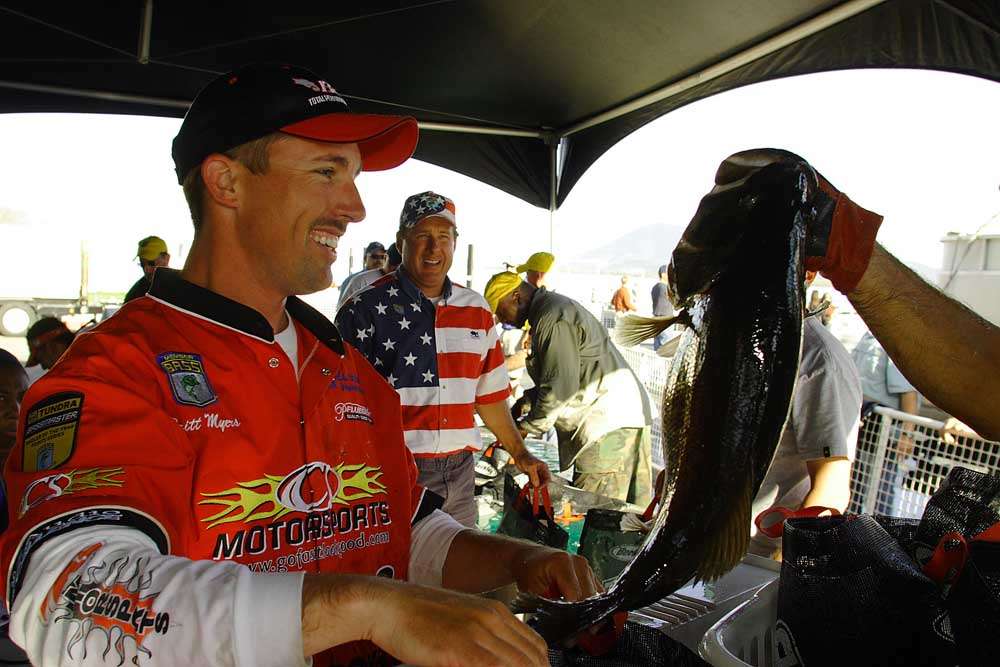
South Carolina's Britt Myers absolutely loves wintertime. No, he's not crazy about cold weather or unduly enamored with Christmas carols. He just loves what winter weather does to the bass in the lakes near his home — Wylie and Norman. And if you'll follow his advice, he's confident you'll love it, too.
The same kind of conditions that make bass fishing difficult for most of us, make it great for this Elite Series pro. What we see as challenges, he sees as opportunities, and he's always ready to capitalize.
"When the water temperature is between 40 and 50 degrees," Myers says, "everything is about the baitfish. If you can find the bait, you can almost always find the bass."
On Wylie and Norman and around much of the country, "bait" means "shad," and finding them requires skill with electronics. That's something Myers has in spades.
"Your electronics are more than just tools to find out how deep it is," he says. "Unfortunately, most anglers don't take the time to get good with their equipment. That's a mistake, but it's one you can fix. You just have to spend time on the water looking at your sonar unit and learning to properly interpret it. The owner's manual will help, so will online videos and articles, but the biggest thing is spending the time doing it. There's really no substitute for that."
Myers uses Lowrance electronics on his BassCat, and his sonar is equipped with sidescan technology so he can see not only what's under his transducer, but also what's off to each side. Taking things a big step further, he rigs his transducers in such a way that his view under the water is different from most.
"On my bow unit I like to split the screen between regular sonar (looking down) and sidescan. Part of the screen shows me what the transducer on the bottom of my electric motor sees and the other half shows the sidescan from the transducer at the rear of the boat," Myers explains. "With those perspectives, I can move and turn the boat to get the best angle on any fish or structure I see. It's like having two boats in the water."
Myers uses his electronics to find bait while cruising through likely areas. But he's not just looking for bait. He wants to see bass, too, and he can do it with his sonar. The bait might be almost anywhere, but he targets his search at this time of year around points — big, obvious ones and more subtle ones. He expects to find the bait and the bass between 15 and 35 feet deep, depending on the water clarity.
"The clearer the water, the deeper I expect to find the bass," he says.
Once he locates them, he determines the best way to present a lure to them — horizontally or vertically. He has four go-to baits at this time of year and says they're all you need to catch bass under these conditions.
"One of my favorite baits at this time of year might seem like an unusual choice for suspended bass," Myers says. "It's a 1/2-ounce War Eagle Screaming Eagle spinnerbait in a shad pattern. I'll fish it down to about 25 feet deep on a long cast, just slow rolling it through the bait and bass."
Myers throws the spinnerbait on a 7-foot medium action Pinnacle Perfecta casting rod (DHC5-701CAMH) with a Pinnacle Optimus XT reel (6.4:1 gear ratio) spooled with 15-pound Berkley Trilene 100% Fluorocarbon line.
He says a light, sensitive rod is critical to success at this time of year because strikes can be subtle and bass lethargic.
He uses the same combo to fish a Zoom Fluke when bass are found shallower than 15 feet. For the Fluke, though, he opts for 12-pound fluorocarbon.
Myers will often go vertical for his bass whenever they're deeper than 18 or 20 feet. For that, he's generally fishing a jigging spoon or grub, both on spinning tackle.
"I like a 1/2- to 5/8-ounce jigging spoon at this time of year," Myers says. "It matches the size of the bait really well, and it has the weight to get down where it needs to be fast. Unlike a lot of guys, though, I like to fish a spoon on spinning tackle. It's just falls so much faster on spinning gear, and until your bait gets down to the fish, you're not really fishing.
"For me, jigging a spoon is the most fun way there is to catch bass."
Myers works the spoon on a 6-foot, 8-inch Pinnacle Perfecta spinning rod (DHC5-681SPM) with a Pinnacle Optimus spinning reel and 6- to 8-pound fluorocarbon line. The spinning reel and light line get the spoon down fast, and Myers likes the way spinning gear handles the bait and the bass during the vertical fight.
His grub of choice is a 3-inch Berkley Power Grub on a 3/16-ounce jighead, and he fishes it on the same spinning outfit as the spoon, though he typically beefs up to 8-pound line.
"I like to rotate between those four baits to keep the action going," Myers says, but he admits that if the bite is fast and furious on one lure there may be no need to change. He finds this to be the case quite often when they're eating the spoon.
As a final tip, Myers says wintertime success can be all about the timing. When he eases over a school of bait or bass with his big engine, he likes to give them an hour or so to settle down before he puts a lure down there.
"If you'll waypoint the spot and come back about an hour later, you'll usually find them in the same area and ready to eat," he says.




